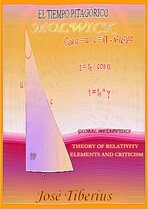2.b) Precursors of the Theory of relativity
At the end of the 19th century, Classical Mechanics from Newton and Galileo’s relativity worked reasonably well. However, there were still things that did not quite fit; there were still things that did not quite fit, such as electromagnetism topics, nature of light or electromagnetic waves, their speed, and the elemental structure of matter.
These intriguing areas of physics impelled scientists to cultivate new solutions. One could say that nowadays the same is happening with other problems. Maybe it has always been that way.
By comparison with the rest of known types of waves, it seemed that electromagnetic waves needed a material through which to propagate.
This model based on the concept of aether, a supporting medium of light. To confirm the model, they hoped to find the absolute velocity of an object dependent on a universal frame of reference, given that the Earth was no longer the center of creation, and the Ptolemaic system had long since been discarded.
2.b.1. Maxwell’s equations of the movement of electromagnetic waves
Maxwell’s equations describe the movement of electromagnetic waves. Given that it is a wave motion; Maxwell’s equations incorporate an undeniable mathematical complexity due to the sinusoidal waves form.
In 1869, Maxwell’s equations made the possible theoretical calculation of the speed of light or electromagnetic waves in general. His equations drove scientists of the time to search for elements that would strengthen the classical model and would incorporate the dynamics of light propagation.
Hertz, in 1887, confirmed experimentally the speed of light determined by Maxwell’s equations.
What no one expected was that, what Maxwell had calculated for a supporting medium of light with a set of conditions, would end up integrated as a postulate or axiom of Special Relativity, independently or without needing a medium.
Until such aether was detected, its existence could not be assured; but a fatal mistake came with Einstein’s Theory of Relativity and its interpretation of the Michelson-Morley experiment.
In other words, he included propagation of electromagnetic waves in vacuum independently of its conditions although the quantitative determination of its velocity depended on the magnetic permeability constants of the vacuum µ0 and the permittivity of the vacuum (dielectric constant) ε0. Curiously, he later incorporated a different effect of the condition of gravitational intensity using the Equivalence Principle in General Relativity.
On Wikipedia, I saw something interesting that I have heard many times. It said that Maxwell’s electromagnetic wave equations predicted a wave that, contrary to the ideas of the time, did not need a medium for propagation. This electromagnetic wave could transmit in a vacuum due to the mutual generation of electric and magnetic fields.
Strange statement when it depended on the constants; in short, history is rewritten in many ways.
The idea about a mutual generation is better not to comment. At least, it was an ingenious idea.
Global Mechanics understands the so-called electric field and magnetic field of the electromagnetic wave equation as the perpendicular components necessary to define torque. Torque is in the perpendicular plane to that of the direction of wave propagation. In other words, the academic difference between magnetic and electric field is entirely conventional and for historical reasons.
Of course, it was not only in Maxwell’s time but also in almost the whole of the 20th century –and indeed, even now– that scientists still confuse vacuum with nothingness –like on Wikipedia–. However, some quantum theories are beginning to recognize openly that classical vacuum is not as “empty” as thought.
Moreover, a dangerous epistemological problem of the philosophy of science acts. In order to accept a proposition, the argument is that because its acceptance in the past, it must be true now. Interesting indeed!
In the section Properties of light waves or photons of the book Global Mechanics, we explore the relative movement of electromagnetic waves and Maxwell’s equations more in-depth.
